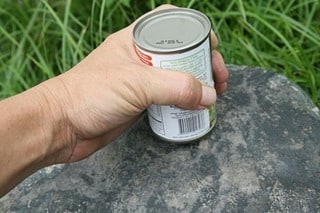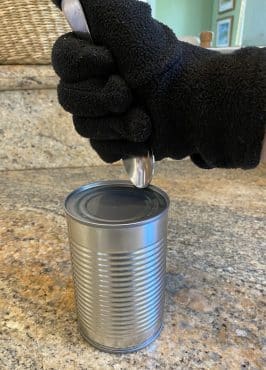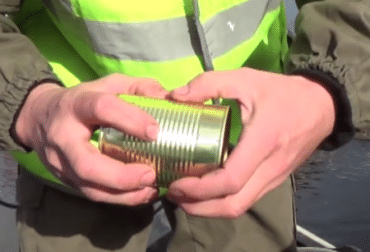Let’s imagine a situation. You’ve got some yummy canned goods — for example, meat, fish, fruit or anything else. But the bad news is that you haven’t got a proper opener! Maybe you’ve lost it and cannot find it again. Maybe you’re somewhere outdoors (for example, camping or hiking) and have forgotten your can opener at home. Maybe it simply has broken and you haven’t bought a new one yet. The situations may be different, but the issue is the same: you have to open a can without a can opener. Is it even possible? Yes, of course! In our article, we’ll tell you about several simple ways to do it. There’s even a method to open cans with bare hands!

But first of all, we need to warn you that there aren’t completely safe methods among them. All of them leave sharp edges, and some of them — even metal shavings or shards. So, we advise you to be extra cautious when following our instructions. We advise you to search for a can opener, and if you find it, never open a can without it. Use these methods only in emergency situations.
So What Cans Can be Opened With?
And now, let’s move on to the methods themselves!
-
Axe
First of all, it’s possible to open a can with an axe. It’s not as scary as it may seem. To do it, you’ll need to turn your can on its side, then cut this side open with the axe blade corner and do it all around its surface.
-
Machete or big knife
The next technique is to open canned food with a big knife or a machete. This technique resembles the previous one — but it’s a bit harder and more dangerous. You’ll also have to lay the can on its side. Then, pierce it with the machete or the knife and cut all the way around.
-
Chef’s knife
This technique requires a large chef’s knife with a blade wider than its handle. In such knives, there’s a small extension of the edge in the lower part. First of all, put the can on a flat surface which is very stable. Never ever, even if you’re on a camping trip or surviving somewhere in the wilderness, put the can anywhere on your body. Your lap or the place between your knees is not a good variant for it, since a slippage of the chef’s knife can cause serious harm.
Take the chef’s knife by the spot where the blade joins the handle and grip it firmly. Be super careful and try not to touch its outer edge. Hold your knife very firmly and don’t let it slip, because this can be very risky. For this method, only a chef’s knife is suitable, not a smaller one like a steak or a pruning knife. The blade needs to be large and heavy enough, otherwise, it simply will not be able to pierce the lid.
Place the corner of the blade’s extension (the back part of it, where its width is the largest) near the edge of the lid. This corner has to be just underneath the center of your hand. Let us repeat that your grip should be extremely firm. Try not to let the knife slip out.
Push the corner in the can’s lid until it punctures a small hole in the metallic surface. Put your other hand on the one that holds the knife and push steadily with both of them. Never hit the can, since it may lead to the knife’s slippage. Press slowly but firmly till a hole appears. Don’t enlarge it with the knife’s end, only with the back corner — it’s much safer both for you and for the knife itself.
Then, make another hole next to it, also near the rim. Make several holes around the perimeter of the entire lid, after which pry the lid open. to do it, plunge the knife tip, spoon handle or any other thin object into one of those holes. Don’t forget that if it’s sharp, you must point it away from you for safety reasons. Also, remember that the lid has a very sharp edge. So, it’s necessary to protect your hand very well by covering it with any thick cloth.
-
Fork
As you may have already guessed, this variant is about using the fork to pierce the can’s lid. However, you don’t need to do it with the whole fork — one prong is much more efficient. It isn’t an easy task, but if you keep pushing it down, you’ll make it. Then turn the prongs away from yourself and try to tear the lid up. It can be done either with the prong or the handle of the fork. The latter variant is even better because the leverage is more convenient. As doing this, turn the can around.
Honestly, it’s not the best way to open a can. If you watch any video about it, you’ll understand what we’re talking about. It’s rather hard to do, especially if you aren’t strong enough physically. The metal of the lid is a bit thick for a fork, so it’ll go very slowly and with great effort. You’ll probably break your fork and never be able to use it again. Also, you may injure your own hands — but in a situation when you don’t have any tools except for a fork it’s your only possible choice.
-
Rough surface

A very messy and dirty method. As with the previous one, it’s suitable only for situations when you don’t have any choice. The technique here is very simple: put the can on a concrete, flat rock or any rough surface) and vigorously rub it until it becomes thin like a foil. Or, at least, when liquid starts to appear. During this process, the contents of the can will probably be contaminated with dust, concrete, or rough rock shards — so, the rough surface method is suitable only in a very dire need, for example, in a survival situation.
-
Metal file
This technique resembles the previous one very much, because it involves an abrasive surface and a scrubbing motion too. The main difference is that here, the can may be held upright. It makes this method much less messy because the contents won’t leak and spill around. But there’s also a high risk that the food inside will be contaminated with metal shavings. So, this method is also suitable mainly for extreme survival cases.
-
Flat-nose pliers
For this easy technique, you’ll need only flat-nose pliers. Other types, such as long-nose ones, won’t be suitable. As usual, place your can on a sturdy table or any other firm and stable surface (never on your lap or in your hand). Then, bend out the outer edge all around the perimeter of the can with the pliers, twisting, crushing, and crimping it in order to separate the lid from the can. Do it with great care but also strength. When the can seal is broken, lift up the lid and fully open the can. This is one of the simplest techniques, it’s much easier than some others from this article such as bare-hand or flat piece of concrete opening.
-
Tin snips
This method is extremely simple and safe, so it’s the most preferable way to open a can without a can opener. You don’t need to make any extra effort. It’s a very clean method too, there won’t be any shards or dust in your food after it, and the food or liquid from it won’t be spilled. The edge of the rim will also be very neat, without any jaggedness that could injure your hands.
First of all, do as usual — take the snips and hold them very firmly, and put the can on a table or other stable horizontal surface. This is very important — the can should be standing on the table. Don’t hold it in your hand or put it on your lap. This is extremely risky and even dangerous because you can hurt yourself if you open a can that way.
Then, cut into the cans rim with the pliers. They should be pointed at an angle. Gradually turn the can around as you’re cutting. Don’t loosen your firm grip. When you’ve already done with approximately 75% of the perimeter of the lid, pry it upwards. Do it very carefully — although it doesn’t have jagged edges, it’s still sharp and can cause injuries. We recommend you to wear gloves.
-
Ordinary or pocket knife

This technique is way better than simply trying to cut off the lid with a knife. If you do it, you’ll probably break the knife and contaminate the can’s contents with pieces of metal.
Instead of a pocket knife, you can use other tools. any thin and sharp metal object of similar sizes, such as a chisel or a flat head screwdriver, will fit.
Gently hit your hand’s back part with your other hand to pierce the lid more easily. But be careful and don’t hit very hard, since in this case, the knife may slip out of control, which is, of course, very undesirable. The hitting motion should be done with an open palm. It will give you a better possibility to keep controlling the knife properly.
Shen you’ve made a small hole in the lid, move the knife some centimeters away and repeat everything, making another one. Puncture several holes around the lid, and then, it will be much easier to open the can fully with the knife.
In order to fulfill this, drive the knife’s end inside one of these holes. Make the hole wider, and then do it again with the rest of them. After that, pull upwards the lid and open the can. Or, alternatively, connect all the holes by cutting around the lid with a sharper and smaller knife. Before opening the can, we recommend you to wrap your hand in something protective such as a towel or even your own sleeve. It will help you avoid scratches from the sharp edges of the opened lid.
-
Spoon

After that, pry the lid open. For it, you can use either the spoon bowl or handle. Beware of the sharp edge of the lid — try not to touch them, or you may cut your fingers. To avoid it, get some gloves beforehand or cover your hand with anything thick enough. Alternatively, you can use a knife or anything that’s comfortable for you.
Also, we need to warn you that you may feel pain in your hands since it requires a lot of physical effort and repetitive movements
Also, remember that the spoon should be very firm, and made of metal, not plastic or wood. But not every metal spoon is suitable for this either — it should be firm and sturdy. Many spoons are made of very thin and weak metal that bends easily. Of course, those ones don’t fit this technique at all — it’s simply impossible to open any can with them.
-
Your bare hands

It’s suitable for any cans, although, with bigger and taller ones, it’s way easier. Also, this method is good only for fully solid food. It’s obviously not suitable for cans that contain a lot of liquid such as fruit in syrup or coconut milk. But even if the food is 100 percent solid, we recommend you put the can into a small plastic bag firstly, to avoid spilling the contents all over the place.
Conclusions for Can Openers
As you may have already seen, there’s a wide variety of ways to open a can of food even if your opener has been lost or broken. The choice is quite wide, and everybody has the possibility to choose the most suitable and convenient technique for them. Have you got a pair of old pliers or tin snips? Amazing! You’ll open your tuna or green beans easily. Haven’t got them? Don’t despair! You’ll probably have a spoon, a fork, or a knife in your kitchen. All of these instruments can come in handy when you need to open a can, just be patient and care for your safety. And in case you have a chef’s knife, it’s even better — it’s a really great tool for this purpose!
But even if you’re camping somewhere and find out with horror that you haven’t taken any of those tools with you — stay calm, everything’s OK! See that flat stone or a slab of concrete? You can use it to open your can, too! Of course, it will possibly be a bit contaminated with dust or unappetizing hard pieces, but in such an extreme situation, it’s not so important, especially if you’re really hungry. It’s better to eat food with a little dust than not to eat anything at all, right?
But what if there isn’t any concrete around? For example, if you’re in a deep forest? And you don’t see perfectly flat stones anywhere nearby? There’s a solution for you too! You can open this yummy food with only your hands! Of course, it’s not easy at all, because it requires great physical strength, but it is still very much possible!
Nevertheless, it’s way better not to lose your opener at all because it’s the only thing that is meant for opening canned food. It’s the safest and easiest method to do it. So, wherever you go — camping, hiking, or traveling, always take your opener with you and try not to lose or forget it anywhere.
For more reading and some other methods, see our frequently asked questions!
Frequently asked question — FAQ
How to open a can using a key?
Some cans have a special key on their top. Such cans were especially popular in earlier times, but now they can be found too. Some people find it difficult to open a can like this, but it’s easier than it seems. To do it, you’ll need to take this key, place it into a hole in the cans side, turn it against the strip and all around, after which just put the lid away and start eating. Bon appetit!
How to repair a can opener?
In case your can opener has stopped functioning properly, check all of its details very attentively. Look if the wheel turns as it should, if the round blade can cut well, and so on. Also, clean it very thoroughly. When you’ve spotted the problem, do what needs to be done — for example, sharpen the blade or change some of the parts.
How to use a tab to open a can?
Opening a can with a tab on it is extremely easy — of course if the tab doesn’t break. Hold the can with one hand and lift one side of the tab (where the hole is) with the other. To do it, put the tip of your finger under it and move it upwards. Instead of your finger, you can use any thin object such as a knife — but be careful and not injure yourself. If everything’s well, the other end of the tab will press into the lid and make a large hole there when you finish pulling the tab up. With some contents, such as mineral water or gas drinks, there’ll be a very distinct hissing sound.
How to open a can that has a broken tab?
It’s possible to do this with a sturdy metal spoon or any ordinary kitchen knife. Place its handle on the lid in the manner of the tab, and then press on it till the can opens. But never try to cut through the lid or apply a screwdriver — it’s totally unnecessary and can be unsafe.
How to use a camp (one-blade) can opener?
Put your can on a flat, stable surface such as a sturdy table, and use your left hand to hold it. You’ll have to use your right hand, even if you’re left-handed, in order not to injure yourself with the opener’s blade. Hold the camping can opener perpendicularly to the cans lid and press the blade down into it. When it makes a hole, move the opener, swing it from back to forth, and go further around the lid, widening the hole and opening the can.



